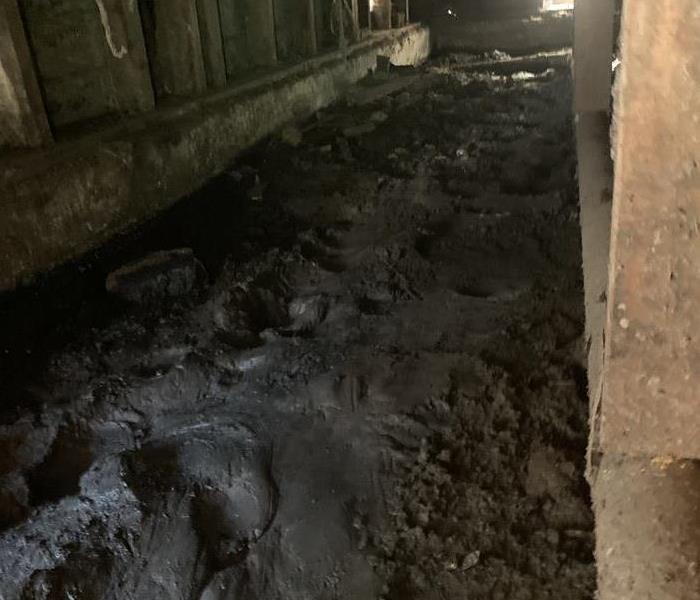Recent Posts
Water Damage and Your HVAC System: Cleaning and Restoration
3/12/2025 (Permalink)
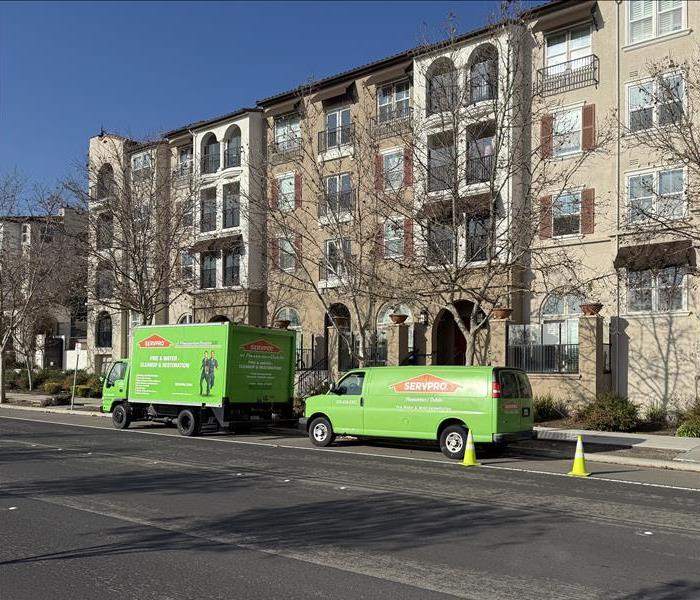 If your HVAC system has been affected by water damage, SERVPRO® is ready to help with expert cleaning, restoration, and preventative maintenance servi
If your HVAC system has been affected by water damage, SERVPRO® is ready to help with expert cleaning, restoration, and preventative maintenance servi
Water damage can affect many parts of a property, but one of the most overlooked areas is the HVAC (Heating, Ventilation, and Air Conditioning) system. Whether caused by leaks, floods, or high humidity levels, water intrusion in your HVAC system can lead to operational issues and costly repairs if not addressed promptly. Knowing how to clean and restore your HVAC system after water damage is essential to maintaining its efficiency and longevity.
In this guide, we’ll walk you through the necessary steps to clean and restore your HVAC system after water damage, ensuring it functions optimally.
Understanding How Water Damage Affects Your HVAC System
Your HVAC system is a critical component of your property’s infrastructure, but it is also vulnerable to water damage. Here’s how water intrusion can impact different parts of the system:
Common Ways Water Can Damage HVAC Systems:
- Flooding in mechanical rooms – Water pooling around HVAC units can damage electrical components and compromise system integrity.
- Leaky ductwork – Moisture can seep into the ductwork, leading to reduced efficiency and increased energy costs.
- Condensation buildup – Excess humidity and poor drainage can result in water accumulating within HVAC components.
- Clogged drain lines – Blocked condensate drain lines can cause overflow and internal water damage to HVAC equipment.
Identifying the source and extent of the water damage is the first step in the cleaning and restoration process.
Steps to Clean and Restore Your HVAC System After Water Damage
If your HVAC system has been affected by water damage, follow these expert-recommended steps to restore it properly:
1. Assess the Damage and Turn Off the System
- Before starting any restoration, turn off the HVAC system to prevent further damage.
- Inspect all components, including ductwork, air handlers, and condenser units, to determine the extent of the water exposure.
- If standing water is present, remove it using pumps or professional water extraction methods.
2. Dry and Dehumidify Affected Areas
- Use industrial fans and dehumidifiers to eliminate excess moisture around the HVAC system.
- Ensure the mechanical room, ducts, and vents are completely dry before proceeding with repairs.
- Address any ongoing humidity issues to prevent future moisture-related problems.
3. Inspect and Clean the Ductwork
- Moisture in the ducts can reduce system efficiency and cause deterioration.
- Use specialized duct cleaning tools to remove any debris and moisture inside the ductwork.
- If water damage is extensive, consider professional duct replacement or sealing services.
4. Check and Repair Electrical Components
- Water exposure can damage electrical connections, posing safety risks and operational failures.
- Hire a qualified technician to inspect wiring, control boards, and circuit breakers.
- Replace any compromised electrical parts before restarting the system.
5. Clean or Replace HVAC Filters
- Remove and discard wet or damaged filters to maintain proper airflow.
- Install high-quality filters to enhance system efficiency and prevent further debris buildup.
- Consider upgrading to moisture-resistant filters if water damage is a recurring issue.
6. Test the System Before Full Operation
- Once all components are cleaned, dried, and repaired, perform a system test.
- Check airflow, temperature control, and noise levels to ensure everything is functioning correctly.
- Monitor the system over the next few days to detect any lingering issues.
Preventative Measures to Protect Your HVAC System from Water Damage
To prevent future water damage to your HVAC system, consider implementing these best practices:
- Schedule regular maintenance – Routine inspections help identify and address potential moisture issues before they escalate.
- Install proper drainage – Ensure condensate drain lines are clear and properly routed away from HVAC units.
- Protect outdoor units – Elevate external HVAC components to prevent flood-related damage.
- Improve ventilation – Proper airflow reduces excess humidity and condensation buildup.
- Seal ductwork – Prevent leaks by sealing and insulating ducts to minimize moisture intrusion.
FAQs About Cleaning and Restoring HVAC Systems After Water Damage
How soon should I restore my HVAC system after water damage?
It’s best to start the restoration process immediately to prevent further system deterioration and avoid costly repairs.
Can I clean my HVAC system myself after water damage?
While you can handle basic drying and filter replacements, professional HVAC restoration is recommended for extensive water exposure.
How much does HVAC restoration cost after water damage?
Costs vary depending on the extent of damage, necessary repairs, and whether components need replacement. A professional inspection will provide a more accurate estimate.
Is water damage to my HVAC system covered by insurance?
Coverage depends on the cause of the water damage and your insurance policy. Contact your provider to review the terms of your coverage.
Can water-damaged ductwork be salvaged?
In some cases, ducts can be dried and cleaned. However, if mold, rust, or structural damage is present, replacing the affected sections may be the best option.
Water damage to your HVAC system can lead to costly repairs and reduced efficiency if not addressed properly. By taking immediate action, thoroughly drying affected areas, and following professional restoration practices, you can restore your HVAC system to optimal performance.
If your HVAC system has been affected by water damage, SERVPRO® is ready to help with expert cleaning, restoration, and preventative maintenance services. Contact us today to ensure your HVAC system is back in peak condition!
Understanding Fire Breaks: A Crucial Tool for Wildfire Prevention
12/12/2024 (Permalink)
A fire break is a crucial tool in wildfire prevention and containment. It is a gap or barrier intentionally created to stop or slow the spread of fire, whether caused by nature or human activity. Fire breaks are strategically designed to deprive a fire of its fuel sources, such as trees, grass, and other vegetation, and can be either man-made or naturally occurring. Understanding fire breaks and their role in fire management is essential, especially in regions prone to wildfires.
How Fire Breaks Work
Fires spread by igniting nearby vegetation, structures, or other combustible materials. A fire break works by creating a clear area devoid of these materials, so the fire cannot continue advancing in that direction. Without fuel, the fire either stops or slows down significantly. This gives firefighters and emergency responders an opportunity to control or extinguish the blaze before it spreads further.
Fire breaks can vary in size depending on the expected intensity of the fire. For small grass fires, a narrow fire break of a few feet may suffice. For larger wildfires in forested areas, much wider fire breaks are needed, often extending hundreds of feet.
Types of Fire Breaks
There are two main types of fire breaks: natural and man-made.
- Natural Fire Breaks: These are pre-existing barriers in the environment that can slow or stop the spread of fire. Examples include rivers, lakes, rocky terrain, and roads. Because these features already exist in the landscape, they can be incorporated into fire management plans with minimal effort.
- Man-Made Fire Breaks: These are created by removing vegetation and combustible materials from a strip of land to form a barrier. Firefighters and forest management teams may clear trees, bushes, and grass or use controlled burns to preemptively remove potential fuel sources. In some cases, heavy machinery is used to plow wide trenches or create roads that act as fire breaks.
The Role of Fire Breaks in Firefighting
During wildfire incidents, fire breaks are essential for firefighters to control and contain the fire. Firefighters often create new fire breaks or enhance existing natural ones to limit the spread of the blaze. Fire breaks also serve as safe zones where firefighters can stage operations, take refuge, or reposition equipment.
In many cases, fire breaks are not only used as part of emergency response but also as a preventive measure. Controlled burns, where firefighters deliberately set small, manageable fires within a fire break, can reduce the amount of flammable material in high-risk areas. This makes it harder for future wildfires to grow out of control.
Importance of Fire Breaks in Wildfire-Prone Areas
For communities located in fire-prone regions, establishing fire breaks can be a lifesaving measure. Property owners can help by maintaining defensible spaces around their homes, such as clearing brush, cutting back trees, and removing debris. Larger fire breaks may be implemented by local fire departments or land management agencies.
In conclusion, a fire break is a critical tool in wildfire prevention and control. Whether naturally occurring or man-made, these barriers reduce the fire's ability to spread, protecting both natural landscapes and human settlements from destruction. For homeowners and communities in fire-prone areas, understanding the importance of fire breaks can make a significant difference in preparing for wildfire threats.
The Hidden Dangers of DIY Water Damage Restoration: Why You Should Rely on Experts
10/16/2024 (Permalink)
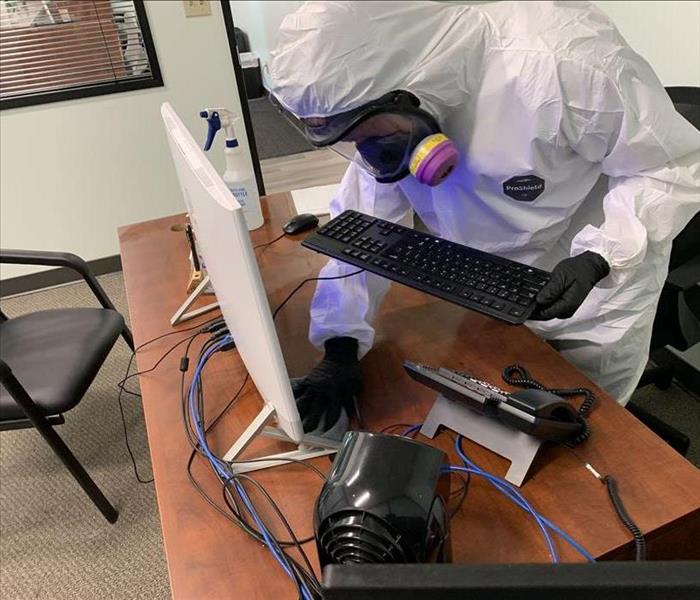 We'll explore the challenges of DIY water damage restoration and highlight expert insights to guide you toward making an informed decision.
We'll explore the challenges of DIY water damage restoration and highlight expert insights to guide you toward making an informed decision.
Water damage can strike unexpectedly in Pleasanton, CA, whether it's due to a burst pipe, flooding, or an unnoticed leak. Your first instinct might be to roll up your sleeves and tackle the issue on your own. However, while a DIY approach may seem like a cost-effective and immediate solution, there are significant limitations and potential risks. In this blog, we'll explore the challenges of DIY water damage restoration and highlight expert insights to guide you toward making an informed decision.
The Limitations of DIY Water Damage Restoration
When water damage occurs, time is of the essence. However, addressing the problem yourself may introduce a number of complications that can lead to long-term issues. Below are some of the key limitations of DIY water damage restoration.
1. Lack of Professional-Grade Equipment
One of the major drawbacks of DIY water damage restoration is the lack of access to professional-grade equipment. Commercial dehumidifiers, air movers, and moisture detectors are essential in effectively drying out affected areas. Household fans and dehumidifiers are simply not powerful enough to handle the extent of water damage seen in most situations.
Professionals use advanced tools that ensure moisture is thoroughly eliminated, reducing the risk of hidden pockets of dampness that can lead to structural damage. Without these tools, your home remains at risk of developing costly future problems.
2. Incomplete Water Extraction
When attempting to extract water using DIY methods, it’s nearly impossible to remove 100% of the moisture. This is particularly true for water that seeps into walls, carpets, and subfloors. Even if the surface appears dry, moisture can still be present deep within the materials.
Water damage restoration experts use high-powered extraction machines that remove excess water far more efficiently than a household wet/dry vacuum. Missing this crucial step can result in further damage, as the remaining water can weaken your home's structural integrity.
3. Inadequate Knowledge and Experience
Restoring water damage requires a deep understanding of how water interacts with different building materials and how to properly treat each situation. Every water damage event is unique, and factors like the type of water (clean, gray, or black) and the extent of saturation play a critical role in determining the best course of action.
Professionals are trained to assess these situations with precision, ensuring that the appropriate measures are taken. Without this knowledge, you may inadvertently overlook critical steps, leading to incomplete restoration.
4. Misidentification of Hidden Damages
Water damage isn't always visible to the naked eye. Moisture can hide behind walls, under floors, and in ceilings, causing damage over time. DIY enthusiasts often miss these concealed areas, which can lead to extensive repairs later on. Professionals use thermal imaging cameras and moisture meters to detect hidden water damage, ensuring that all affected areas are addressed promptly.
5. Time-Consuming and Stressful
Water damage restoration is a time-sensitive process that can quickly become overwhelming without the right resources and expertise. The time and effort required to perform DIY restoration can be considerable, leading to frustration and potentially worsening the situation if not handled swiftly.
On the other hand, professional restoration teams have the manpower, tools, and experience to complete the job efficiently and effectively, minimizing stress and disruption to your life.
Why Professional Water Damage Restoration Is Worth the Investment
While attempting to handle water damage on your own might seem cost-effective, the potential risks and challenges often outweigh the initial savings. Investing in professional water damage restoration can save you money in the long run by preventing further damage and ensuring your home is fully restored.
In fact, the Water Damage Restoration Industry Report highlights that professional services reduce the likelihood of costly secondary damage by 30 percent. This statistic underscores the importance of having trained professionals address water damage quickly and comprehensively.
Benefits of Hiring Professional Restoration Services:
- Access to Specialized Equipment: Professionals use state-of-the-art tools for complete water extraction and drying.
- Comprehensive Assessment: Experts can identify hidden damage and ensure all affected areas are treated.
- Efficiency: A professional team can restore your home much faster than DIY efforts, reducing the risk of further damage.
- Peace of Mind: Knowing that your home is being restored by qualified professionals allows you to focus on other priorities during a stressful time.
Conclusion: Trust the Experts for Water Damage Restoration
Understanding the limitations of DIY water damage restoration is essential in making the right decision for your home. While it may be tempting to tackle the issue yourself, the risks of incomplete extraction, hidden damages, and inadequate equipment can lead to more significant problems in the future. By relying on professional water damage restoration services, you ensure that your home is restored safely, efficiently, and effectively—giving you peace of mind and protecting your investment for the long term.
Mold in Schools: Understanding the Risks and How to Prevent It
10/16/2024 (Permalink)
Mold in schools is a significant concern for both students and staff, as it can thrive in moist environments and lead to structural and operational challenges if left unchecked. Though the focus in mold-related discussions often centers around health risks, there are additional concerns about the impact on the building’s integrity and the overall learning environment. Understanding the causes of mold in schools, how to prevent it, and when to seek professional help, such as the services offered by SERVPRO®, is essential to maintain a safe and comfortable space for education.
Causes of Mold in Schools
Mold is a fungus that thrives in areas with excessive moisture. Schools, like other buildings, are vulnerable to mold growth for several reasons:
- Poor Ventilation: Classrooms, gymnasiums, and locker rooms often have insufficient ventilation, creating damp, humid conditions where mold can thrive. This is particularly true in older school buildings that may not have modern HVAC systems.
- Leaking Roofs or Windows: School roofs and windows that are not properly sealed can allow water to seep in, creating the ideal conditions for mold to grow. If water damage is not addressed immediately, mold can spread quickly.
- Plumbing Issues: Bathrooms, kitchens, and science labs in schools may have leaking pipes or faulty plumbing, leading to water accumulation in hidden areas such as behind walls or under floors.
- High Humidity Levels: In regions with high humidity, moisture levels in schools can remain consistently high, particularly in areas like basements, attics, or crawl spaces.
Risks of Mold in Schools
A major risk is the structural damage it can cause. Mold feeds on organic materials like wood, paper, and drywall, which are commonly found in school buildings. If mold grows unchecked, it can weaken walls, floors, and ceilings, requiring extensive and costly repairs.
Additionally, mold in classrooms and common areas can affect air quality, which may impact the overall environment for learning. Musty odors and visible mold growth can create distractions and discomfort for students and teachers alike.
Prevention Measures for Mold in Schools
Preventing mold in schools requires a proactive approach to managing moisture and ensuring proper building maintenance. Here are some key prevention strategies:
- Regular Inspections: Conduct routine checks of areas prone to moisture buildup, including bathrooms, kitchens, and basements. Look for signs of water damage such as staining, warping, or peeling paint.
- Address Leaks Promptly: Whether it's a roof leak or a plumbing issue, repairs should be made immediately to prevent water accumulation. This also means inspecting windows and doors to ensure they are properly sealed.
- Maintain HVAC Systems: Ensure that ventilation systems are working properly to keep humidity levels under control. Schools should also clean air ducts regularly to avoid mold buildup.
- Control Humidity: Use dehumidifiers in areas where moisture levels tend to rise, especially in humid climates. Keeping the indoor humidity below 60% is crucial in preventing mold growth.
- Educate Staff and Students: Make sure teachers, custodians, and maintenance staff are trained to recognize early signs of mold and understand the importance of reporting leaks or water damage.
SERVPRO: Mold Remediation for Schools
If mold is discovered in your school, it’s important to seek professional help to ensure complete and effective remediation. SERVPRO specializes in mold remediation services, utilizing advanced techniques to identify, contain, and eliminate mold colonies. With industry expertise and proper equipment, SERVPRO can restore mold-affected areas in schools to safe conditions while addressing underlying moisture issues to prevent future occurrences.
By investing in mold prevention and remediation strategies, schools can protect both their structural integrity and the learning environment, ensuring students and staff have a safe and healthy space in which to thrive. If your school is facing mold issues, don’t hesitate to contact SERVPRO of Pleasanton/Dublin for expert assistance in mold removal and prevention.
Ensuring Storm Resilience: Essential Roofing Repairs and Maintenance with SERVPRO®
9/11/2024 (Permalink)
The roof is your home’s first line of defense against the elements, making it crucial for protecting your property during storms. Proper roofing repairs and maintenance are essential for ensuring your home’s resilience against severe weather. In this blog, we’ll explore the importance of maintaining your roof, the steps to take for storm preparedness, and how SERVPRO® can assist in keeping your roof in top condition.
The Importance of Regular Roof Maintenance
- Prolongs Roof Lifespan: Regular maintenance can significantly extend the life of your roof by preventing minor issues from becoming major problems.
- Prevents Water Damage: A well-maintained roof prevents leaks that can cause extensive water damage to your home’s interior, including walls, ceilings, and insulation.
- Energy Efficiency: Maintaining your roof helps preserve its integrity, ensuring proper insulation and reducing energy costs.
Key Maintenance Practices for Storm Resilience
- Regular Inspections: Schedule regular roof inspections, especially before storm season. Look for missing or damaged shingles, tiles, or flashing.
- Clean Gutters and Downspouts: Ensure gutters and downspouts are free of debris to allow proper water drainage and prevent water buildup that can damage the roof and foundation.
- Trim Overhanging Branches: Remove branches that hang over your roof to prevent them from breaking and causing damage during high winds.
- Check for Moss and Algae: Remove moss and algae growth, which can retain moisture and cause roof deterioration.
- Seal Cracks and Holes: Inspect and seal any cracks or holes in the roof and around vents, chimneys, and skylights to prevent water infiltration.
Repairing Storm Damage
- Immediate Response: After a storm, inspect your roof for damage as soon as it is safe to do so. Look for signs of damage such as missing shingles, leaks, or visible structural issues.
- Document the Damage: Take photos and make notes of any damage to assist with insurance claims and to provide to professional repair services.
- Temporary Fixes: Use tarps or plywood to cover damaged areas temporarily to prevent further damage until professional repairs can be made.
The Role of Professional Roofing Services
- Expert Assessment: Professional roofers can provide a thorough inspection and identify both visible and hidden damage that may require repair.
- Quality Repairs: Trained professionals ensure repairs are done correctly, using the appropriate materials and techniques to restore your roof’s integrity.
- Preventive Measures: Professionals can recommend and implement preventive measures to enhance your roof’s resilience against future storms.
How SERVPRO Can Help
- Storm Damage Assessment: SERVPRO offers comprehensive storm damage assessment services to identify the extent of roof and structural damage.
- Emergency Roof Tarping: To prevent further damage, SERVPRO provides emergency roof tarping services, securing your home until permanent repairs can be made.
- Water Damage Restoration: If your roof damage has led to water infiltration, SERVPRO’s water damage restoration services can mitigate the impact and restore affected areas.
- Mold Remediation: In case of prolonged water exposure, SERVPRO offers mold remediation services to ensure your home remains safe and healthy.
- Coordination with Insurance: SERVPRO works with your insurance company to streamline the claims process and ensure you receive the coverage you need for repairs.
Maintaining and repairing your roof is crucial for storm resilience and the overall protection of your home. Regular inspections, timely repairs, and professional services play a significant role in keeping your roof in top condition. SERVPRO’s expertise in storm damage assessment and restoration ensures your home is prepared for and can recover from severe weather. Trust SERVPRO of Pleasanton/Dublin to help you maintain a strong, resilient roof, giving you peace of mind in any storm.
Essential Steps to Take in Case of a House Fire and the Role of Professional Restoration Services
8/6/2024 (Permalink)
A house fire is a frightening and potentially devastating event. Knowing what to do in the immediate aftermath can save lives and minimize damage. This blog will guide you through the critical steps to take if a fire occurs in your home and highlight the importance of professional fire restoration services, such as those provided by SERVPRO®, to help you recover and restore your property.
Immediate Actions During a House Fire
- Stay Calm and Act Quickly:
- Alert Others: Yell “Fire!” to alert everyone in the house. Ensure everyone knows the emergency plan and exits the building immediately.
- Evacuate: Leave all belongings behind. Your priority is to get yourself and your family to safety.
- Use the Nearest Exit:
- Safe Exit Routes: If possible, use the closest and safest exit. If there is smoke, stay low to the ground to avoid inhaling it.
- Check Doors: Feel the door with the back of your hand before opening it. If it’s hot, do not open it and find an alternative exit.
- Stop, Drop, and Roll:
- Clothing on Fire: If your clothes catch fire, stop immediately, drop to the ground, and roll over to smother the flames. Cover your face with your hands to protect it.
- Do Not Use Elevators:
- Staircases Only: Always use staircases, not elevators, during a fire evacuation as elevators can become inoperable or take you to the fire floor.
- Call 911:
- Outside the House: Once you are safely outside, call 911 to report the fire. Provide them with as much detail as possible, including your address and any known details about the fire.
- Stay Outside:
- Do Not Re-enter: Do not go back inside for any reason. Wait for the fire department to arrive and extinguish the fire.
After the Fire: Ensuring Safety and Beginning Recovery
- Contact Family and Friends:
- Inform: Let your family and friends know you are safe. They can offer support and assistance during this difficult time.
- Secure Your Property:
- Board Up: If safe to do so, board up any broken windows or doors to prevent further damage or theft. SERVPRO can assist with emergency board-up services.
- Document Damage:
- Take Photos: Document the damage by taking photos or videos. This will be helpful for insurance claims.
- Contact Your Insurance Company:
- Report the Fire: Inform your insurance company about the fire as soon as possible. They will guide you through the claims process.
Professional Fire Restoration and Cleanup with SERVPRO
SERVPRO professionals will conduct a thorough assessment of the damage to develop an effective restoration plan. We provide board-up and roof-tarp services to protect your property from further damage and unauthorized entry. If water was used to extinguish the fire, SERVPRO will remove excess water and use industrial-grade equipment to dry the affected areas, preventing mold growth.
Knowing what to do in the event of a house fire can save lives and reduce damage. After ensuring your safety, it’s crucial to engage professional restoration services to handle the aftermath. SERVPRO expertise in fire restoration and cleanup ensures that your property is restored efficiently and thoroughly, allowing you to recover and rebuild with peace of mind. If you experience a house fire, trust SERVPRO of Pleasanton/Dublin to help you navigate the recovery process and restore your home to its former state.
How Does Mold Get Into the HVAC System?
7/16/2024 (Permalink)
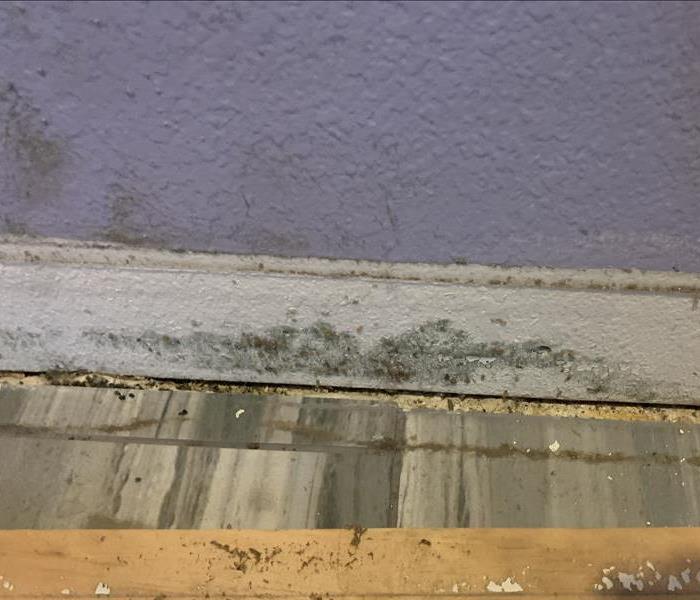 Mold in your HVAC system can cause serious damage to your home.
Mold in your HVAC system can cause serious damage to your home.
Mold in your HVAC system is a serious problem that can cause extensive property damage and impact your home's air quality. Understanding how mold gets into the HVAC system is crucial for prevention and effective remediation. In this blog, we will explore the causes of mold growth in HVAC systems and offer some tips to prevent it.
What Causes Mold Growth in HVAC Systems?
Mold spores are a natural part of the environment and can easily enter your home. Once inside, they can find their way into your HVAC (Heating, Ventilation, and Air Conditioning) system. Here are some common ways mold can infiltrate your HVAC system:
1. Moisture Buildup
One of the primary factors for mold growth is moisture. HVAC systems can accumulate moisture through condensation. When warm, humid air passes over the cold evaporator coils, condensation forms. If this moisture isn't properly drained, it can create a perfect environment for mold growth.
2. Dirty Filters
Dirty or clogged filters can restrict airflow, causing moisture to build up in the system. When filters aren't changed regularly, dust and debris can accumulate, providing nutrients for mold spores. Over time, these spores can grow into mold colonies.
3. Poor Ventilation
Proper ventilation is crucial for preventing mold. When there is poor ventilation in your HVAC system, moisture can become trapped. Stagnant air combined with moisture creates an ideal breeding ground for mold. Ensuring your system has adequate ventilation can help reduce this risk.
4. Leaking Ducts
Leaks in your ductwork can allow humid air to enter the system. When this humid air comes into contact with cooler surfaces within the HVAC system, it can cause condensation. This moisture can then lead to mold growth. Regular inspection and maintenance of ductwork can help prevent leaks and moisture buildup.
5. Standing Water
Standing water in any part of your HVAC system can lead to mold growth. This can occur in drip pans, condensate lines, or other areas where water may accumulate. Ensuring that these components are regularly cleaned and maintained is essential.
Signs of Mold in Your HVAC System
Recognizing the signs of mold in your HVAC system early can help prevent extensive damage and health issues. Some common indicators include:
- Musty odors coming from your vents.
- Visible mold growth on vents or around the HVAC unit.
- Increased allergy symptoms or respiratory issues among household members.
- Frequent headaches, nausea, or fatigue.
If you notice any of these signs, it’s essential to address the issue as quickly as possible.
Preventing Mold in Your HVAC System
Prevention is key when it comes to mold in your HVAC system. Here are some tips to help keep your system mold-free:
- Regular Maintenance
Regular maintenance of your HVAC system is crucial. This includes cleaning coils, drip pans, and other components where moisture can accumulate. A professional HVAC technician can perform these tasks and identify any potential issues.
- Change Filters Regularly
Changing your HVAC filters regularly is one of the easiest ways to prevent mold. Clean filters ensure proper airflow and reduce the chance of moisture buildup. Check your filters monthly and replace them as needed.
- Ensure Proper Ventilation
Make sure your HVAC system is properly ventilated. This can help reduce moisture buildup and prevent mold growth. If necessary, consider installing a dehumidifier to control humidity levels in your home.
- Inspect Ductwork
Regularly inspect your ductwork for leaks and other issues. Seal any leaks promptly to prevent humid air from entering the system. Properly insulated ducts can also help maintain consistent temperatures and reduce condensation.
- Keep the Area Dry
Ensure that the area around your HVAC system is dry. Fix any leaks or water issues promptly, and use a dehumidifier in damp areas to keep humidity levels in check.
Mold in your HVAC system can cause serious damage to your home. By understanding how mold gets into the system and taking preventive measures, you can keep your HVAC system mold-free. Regular maintenance, proper ventilation, and prompt attention to moisture issues are key to preventing mold growth. If you suspect mold in your HVAC system, contact a professional mold remediation service like SERVPRO® to ensure safe and effective removal.
The Importance of Professional Water Extraction Services
6/12/2024 (Permalink)
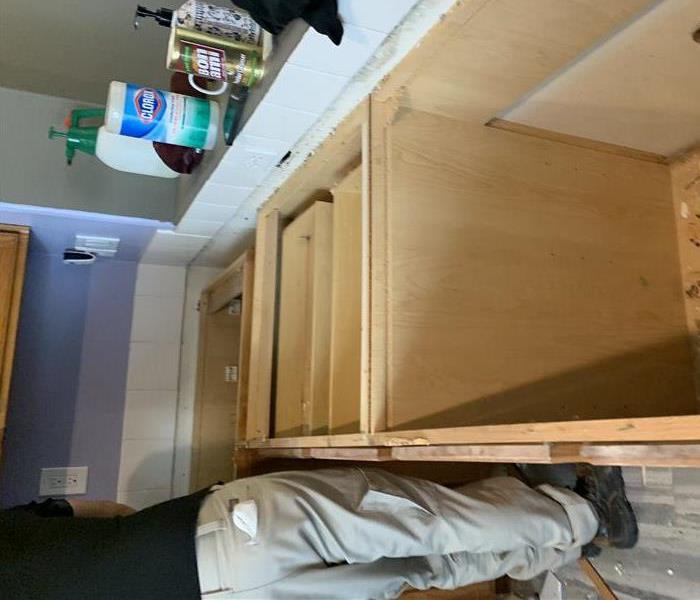 Our team will perform water extraction services and cleanup after any type of water damage.
Our team will perform water extraction services and cleanup after any type of water damage.
Water damage is a common issue that can wreak havoc on your property, and it can be caused by various factors, ranging from heavy rainfall to burst pipes. When water damage occurs, it is essential to act quickly to minimize the damage and prevent the spread of unwanted bacteria and mold.
One critical step in the water damage restoration process is professional water extraction. Water extraction involves removing any standing water from your property and drying out any moisture in the affected areas. It is critical to have a qualified and well-equipped team of professionals perform this task to ensure that your property is properly restored.
The importance of professional water extraction services cannot be overstated. Here are a few reasons why you should always enlist the help of experts when dealing with water damage.
Prevents Structural Damage:
Water can cause significant damage to the structure of your home or business. If left untreated, the water can seep into the walls, floors, and ceilings, weakening their integrity and compromising their stability. This can lead to serious structural damage and may require extensive repairs or even complete replacement. Professional water extraction services can prevent this damage by thoroughly removing all excess water from your property and implementing measures to dry and dehumidify the area. This helps to ensure that the structural components of your property remain intact and protected.
Prevents Mold Growth:
Mold growth can be a significant issue after a water damage event. Moisture-rich environments are breeding grounds for mold and other harmful bacteria that can pose a health risk to humans and pets. If not adequately addressed, mold can spread quickly, causing respiratory issues, skin irritation, and other health problems. Professional water extraction services can help prevent mold growth by removing excess moisture from the affected areas and implementing proper ventilation and airflow.
Saves Time and Money:
Water damage restoration can be a costly and lengthy process. The longer the water sits, the more damage it can cause, and the more expensive restoration becomes. By enlisting the help of professional water extraction services, you can save time and money in the long run. Professionals have access to specialized equipment and are trained to identify and address all areas where water damage may be present. This ensures that the water is thoroughly extracted, and the restoration process can begin as quickly as possible.
Assists with Insurance Claims:
Water damage can be overwhelming, particularly when dealing with insurance claims. Professional water extraction services can provide detailed documentation of the damage and the restoration process. This can assist with insurance claims and ensure that you receive fair compensation.
In conclusion, professional water extraction services are a critical component of the water damage restoration process. They prevent structural damage, prevent mold growth, save time and money, and assist with insurance claims. By enlisting the help of trained and experienced professionals, you can rest assured that your property will be properly restored to its pre-damage condition. If you have experienced water damage, don't hesitate to call SERVPRO® to ensure a prompt and professional restoration.
The Importance of Air Quality Testing After a Fire
4/17/2024 (Permalink)
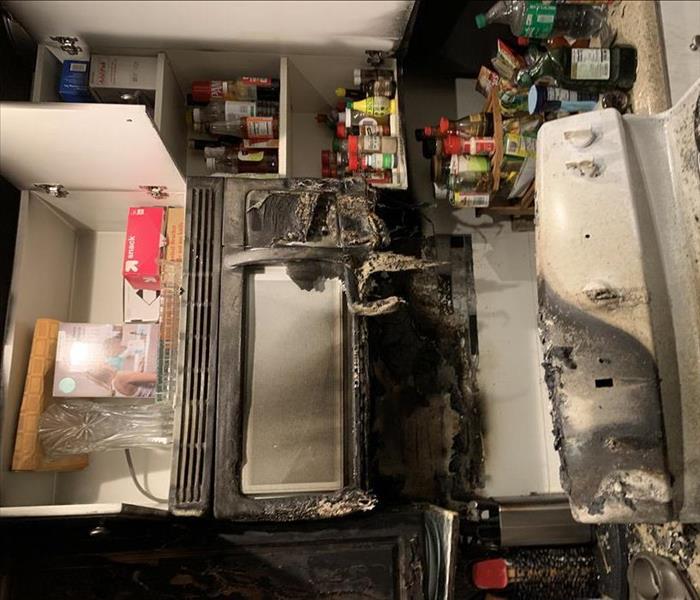 In this blog, we will explore the reasons why air quality testing is essential after a fire, as well as how these tests work.
In this blog, we will explore the reasons why air quality testing is essential after a fire, as well as how these tests work.
After experiencing a fire, the immediate focus is often on assessing and repairing visible damage. However, the air quality within a fire-damaged structure is equally crucial to address. Air quality testing plays a vital role in ensuring a safe environment for occupants and aiding in effective fire damage restoration. In this blog, we will explore the reasons why air quality testing is essential after a fire, as well as how these tests work. By understanding the importance of air quality testing, homeowners and businesses can take the necessary steps to restore a healthy living or working environment.
Importance of Air Quality Testing After a Fire
- Identification of Invisible Contaminants: Smoke and soot particles left behind after a fire can permeate the air and settle on surfaces, leading to long-term exposure risks. Without air quality testing, these invisible contaminants can go unnoticed, posing potential health hazards to occupants. Testing helps identify the presence of harmful particles, allowing for appropriate remediation measures.
- Comprehensive Restoration: Building materials, including walls, ceilings, and floors, may release volatile organic compounds (VOCs) when exposed to fire and smoke. These compounds can impact the air quality and linger long after the fire has been extinguished. Air quality testing helps ensure that comprehensive restoration efforts address these compounds, creating a healthy and habitable environment.
- Effective Remediation Planning: Knowing the level and types of contaminants in the air is crucial for planning effective fire damage restoration. Air quality testing provides valuable data on the extent of contamination, allowing professionals to make informed decisions regarding the remediation process. This ensures that the appropriate techniques and equipment are utilized to restore air quality effectively.
How Air Quality Tests Work
- Initial Assessment: Certified professionals, such as those from SERVPRO®, conduct a comprehensive evaluation of the fire-damaged structure to determine the key areas of concern. They identify potential sources of contamination and develop a testing plan accordingly.
- Sample Collection: Various methods are used for air quality testing, including air samplers, particle counters, and gas analyzers. These tools collect samples of the indoor air, as well as particles settled on surfaces and materials. The samples are then sent to a laboratory for analysis.
- Laboratory Analysis: In the laboratory, the collected samples undergo rigorous testing and analysis. Professionals assess the composition of the air, measure the levels of particulate matter, and identify the presence of harmful chemicals or VOCs. The results provide critical insights into the air quality and contamination within the space.
- Interpretation of Results: Once the analysis is complete, professionals interpret the results to determine if air quality remediation is necessary. Based on the findings, they developed a customized plan for restoring and improving the air quality.
Air quality testing after a fire is a crucial step in the fire damage restoration process. It helps identify invisible contaminants, facilitates comprehensive restoration efforts, and enables effective remediation planning. By investing in professional air quality testing, homeowners and businesses can ensure a safe and healthy living or working environment post-fire. Certified professionals, such as those from SERVPRO, employ advanced techniques and equipment to collect samples and conduct thorough laboratory analyses. Remember, when it comes to fire damage restoration and air quality testing, rely on certified experts to restore your property to its pre-fire condition and promote a healthy indoor environment.
8 Tips for Keeping your Vacation Home Mold Free
3/14/2024 (Permalink)
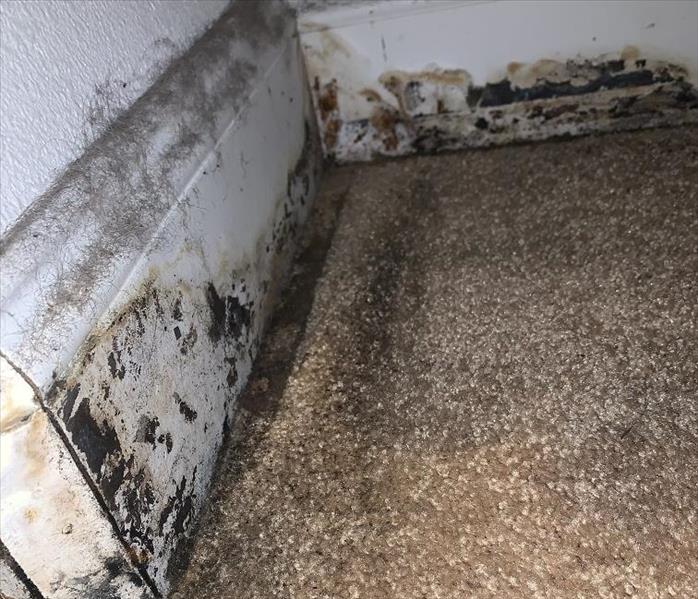 Owning a vacation home is a joy, but keeping it mold-free, especially during periods of vacancy, can be a concern.
Owning a vacation home is a joy, but keeping it mold-free, especially during periods of vacancy, can be a concern.
Owning a vacation home is a joy, but keeping it mold-free, especially during periods of vacancy, can be a concern. We've got you covered with eight practical tips to maintain a mold-free vacation home throughout the year. These simple yet effective measures will help you return to your retreat worry-free.
- Humidity Control
Invest in a dehumidifier to regulate indoor humidity levels, especially during warmer seasons. Mold thrives in damp environments, so keeping humidity in check is a crucial preventive step.
- Prioritize Ventilation
Ensure good ventilation by utilizing exhaust fans and leaving windows open when possible. Adequate airflow helps minimize moisture buildup, creating an environment less conducive to mold growth.
- Regular Cleaning Routine
Dust and dirt can create a breeding ground for mold. Establish a routine for regular cleaning, even during the off-season, to prevent the accumulation of particles that may contribute to mold issues.
- Leak Inspection
Conduct regular inspections for leaks both inside and outside your vacation home. To prevent mold from growing and spreading, promptly fix any leaks you find as quickly as possible.
- Roof Check-Up
Regularly inspect your vacation home's roof for signs of damage. A well-maintained roof is your first line of defense against water leaks, helping to stave off potential mold concerns.
- Tighten Up Windows and Doors
Ensure that windows and doors are tightly sealed to prevent rain or humidity from seeping in. Proper sealing helps protect against unwanted moisture that could lead to mold growth.
- Keep It Sunlit
Sunlight is a natural mold deterrent. During your visits, open curtains and blinds to let the sunlight in. This not only brightens up your space but also prevents mold development.
- Prioritize Regular Mold Checks
It's essential to add mold checks to your inspection checklist for thorough maintenance. Mold can be a silent intruder, and regular assessments ensure early detection and timely intervention. During your routine inspections, pay close attention to areas prone to moisture, such as bathrooms, kitchens, and basements. Look for any signs of water damage, discoloration, or musty odors. Also remember to inspect ventilation systems and windows to ensure proper airflow, reducing the risk of humidity buildup.
By incorporating these practical tips into your vacation home maintenance routine, you'll create an environment that's less welcoming to mold, allowing you to enjoy your retreat mold-free year-round.
 If your HVAC system has been affected by water damage, SERVPRO® is ready to help with expert cleaning, restoration, and preventative maintenance servi
If your HVAC system has been affected by water damage, SERVPRO® is ready to help with expert cleaning, restoration, and preventative maintenance servi





 24/7 Emergency Service
24/7 Emergency Service